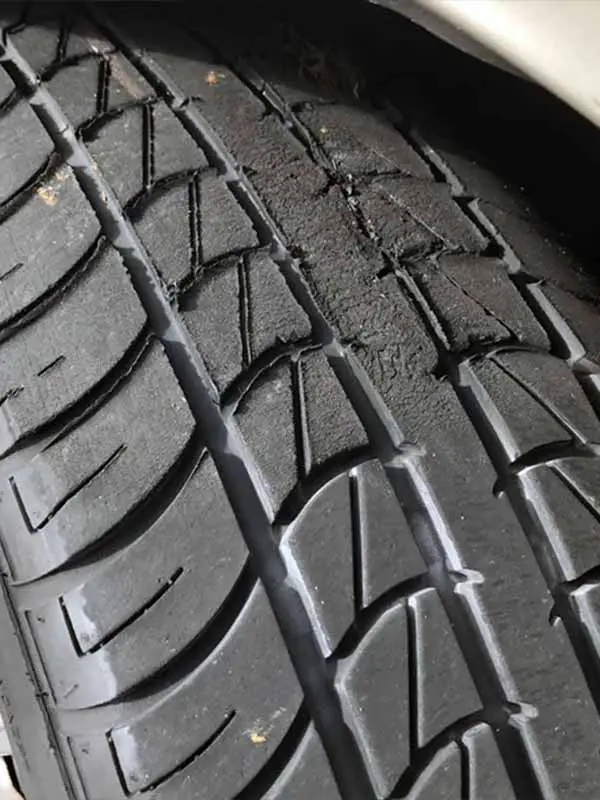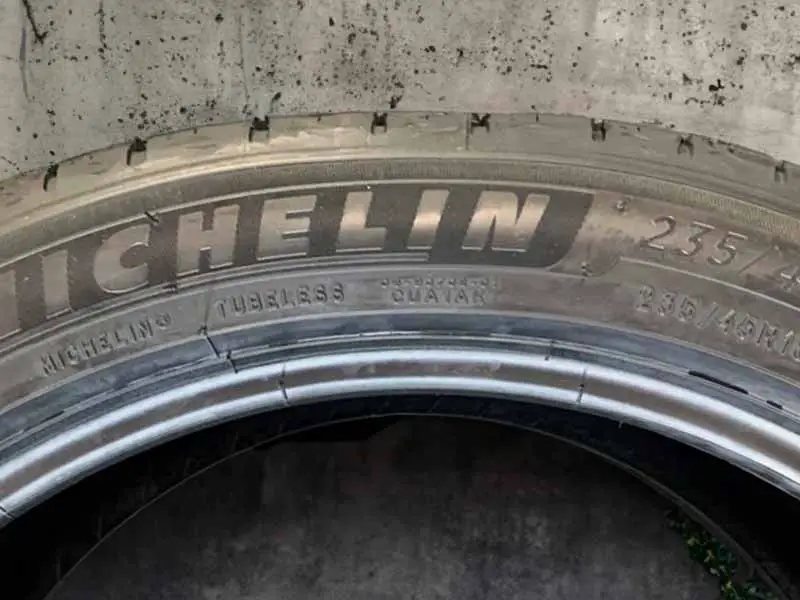Ever noticed a strange vibration or a persistent thumping sound while driving your car? It could be more than just a rough road; these symptoms might point to flat spots on your tires.
Symptoms of Flat Spots On Tires
- Visually, you can see noticeable deformations on the tire’s surface
- Audibly, there may be a rhythmic thumping sound as the tire rotates
- Physically, you can feel vibrations in the steering wheel or seat while driving, particularly at higher speeds.
- Handling, you may notice reduced traction under certain conditions.
In this article, we explore the causes, symptoms, dangers, and solutions for flat spots on tires, providing practical advice for both prevention and maintenance.

What Are Tire Flat Spots?
Flat spots on tires are exactly what they sound like – areas on the tire that have become flat due to pressure and inactivity. They occur in two main scenarios:
- Due to Prolonged Parking: When your car sits in the same spot for an extended period, the weight of the vehicle presses down on the tires. This constant pressure can deform the rubber, leading to flat spots.
- Due to Skidding: A moment of abrupt braking or skidding can literally leave its mark on your tires. The friction generated in such instances can wear down the tread unevenly, creating a flat spot.
Why Should You Care?
- Safety First: Flat spots can compromise the integrity of your tires, potentially leading to unsafe driving conditions.
- Comfort: A smooth ride can turn bumpy and uncomfortable with uneven tires.
- Vehicle Health: Ignoring flat spots can lead to more serious tire damage and impact overall vehicle performance.
Understanding the nature of flat spots is the first step in addressing them. For a deeper dive into whether a flat spot on your tire will correct itself, check out our detailed guide on tire flat spot self-correction.
Symptoms of Flat Spots
Identifying flat spots on tires is crucial for timely intervention and maintenance. Here’s how you can spot them and understand their impact on your driving experience:

Visual and Tactile Indicators
- Visual Inspection: Regularly inspect your tires for visible signs of flat spots, characterized by noticeably flattened areas on the tire’s surface.
- Touch Test: Running your hand over the tire can also reveal irregularities in the surface, indicating potential flat spots.
The Telltale Vibrations
- Vibration Sensation: One of the most common symptoms of flat spots is an unusual vibration felt while driving, particularly noticeable at higher speeds.
- Understanding Vibrations: These vibrations occur because the flat spot disrupts the tire’s uniform rotation, leading to an uneven distribution of force as the tire rolls.
Impact on Driving
- Steering and Control: These vibrations can affect steering precision and overall control of the vehicle, potentially making driving more challenging and less comfortable.
- Long-Term Effects: Continuous driving on flat-spotted tires can exacerbate the issue, leading to further tire damage and degraded performance.
How To Fix Flat Spots Due To A Skid
Fixing flat spots caused by skidding requires specific methods:
Tire Shaving
- What It Involves: Tire shaving evenly removes a layer of tread from the entire tire, reducing the prominence of the flat spot.
- Considerations: This method shortens tire life, as the amount of tread removed depends on the depth of the flat spot caused by the skid.
Other Methods
- Inspection and Balancing: A professional can inspect the tire to determine if balancing or rotation could help.
- Replacement: In cases where the flat spot is too severe, tire replacement might be the only safe option.
Tire shaving can be a viable solution, but it’s crucial to weigh the impact on tire longevity against the benefits of a smoother ride.

How To Fix Flat Spots Due To Extended Parking
Dealing with flat spots caused by extended periods of parking involves a few straightforward steps:
Gradual Use
- Resume Regular Driving: Often, simply driving the vehicle regularly can help the tires regain their shape, especially if the flat spots are not severe.
Tire Inspection
- Check Tire Pressure: Ensure that the tires are properly inflated according to the manufacturer’s recommendations.
- Visual Inspection: Look for signs of irreversible damage or severe wear.
Professional Advice
- Seek Expert Opinion: If the flat spots don’t improve with regular use, consult a tire specialist to assess whether the tires need repair or replacement.
When to Replace Flat-Spotted Tires
Based on these observations and assessments, you can make an informed decision about whether to replace a flat-spotted tire. Remember, safety should always be the priority.
For Flat Spots from Extended Parking:
- Visual Deformation: Look for significant flattening where the tire has been in contact with the ground.
- Persistent Vibration: After resuming regular driving, if vibrations persist, it indicates a potentially irreversible flat spot.
- Irregular Tread Wear: Check for uneven tread wear, which can signal more serious internal damage.
For Flat Spots from Skidding:
- Deep Tread Wear: Skidding can cause the tread to wear down to the wear bars or deeper, indicating a need for replacement.
- Exposed Cords: If the skid has worn the tire down to its cords, it’s a clear sign the tire is no longer safe.
Step-by-Step Damage Assessment
- Inspect Tire Surface: Examine the entire circumference of the tire for flat areas and wear patterns.
- Measure Tread Depth: Use a tread depth gauge to measure the depth at the flat spot and compare it to the rest of the tire.
- Check for Vibrations: Drive the vehicle at various speeds to test for abnormal vibrations.
- Evaluate Age and Wear: Consider the overall age and wear of the tire; older tires may be more susceptible to damage.
- Professional Inspection: If in doubt, have the tire inspected by a professional for a comprehensive assessment.

Jack Stands
Prevention and Maintenance
Preventing flat spots, whether from extended parking or skidding, involves a few key strategies:
For Extended Parking
- Regular Movement: Move the vehicle periodically to prevent prolonged pressure on one spot of the tire.
- Proper Inflation: Keep tires properly inflated even when the vehicle is not in use.
- Use of Tire Supports: Consider using jack stands or cradles for long-term parking.
For Skidding
- Smooth Braking: Practice gradual braking techniques to avoid sudden stops that cause skidding.
- Awareness of Road Conditions: Be mindful of road conditions that can lead to skidding, such as wet or icy surfaces.
Regular tire maintenance and mindful driving habits can significantly reduce the risk of flat spots from both extended parking and skidding.

Tire Cradle
Causes of Flat Spots
Understanding the causes of flat spots on tires is key to their prevention and maintenance. Let’s explore the two primary culprits:
Flat Spots Due to Inactivity
Imagine leaving your vehicle parked in the same spot for weeks or even months. Here’s what’s happening to the tires:
- Constant Pressure: The weight of the car consistently pressing down on the same part of the tire can cause that segment to flatten.
- Rubber’s Response: Tire rubber is designed to be resilient, but prolonged pressure can lead to permanent deformation, creating a flat spot.
Flat Spots from Skidding
Skidding is a more dramatic cause, often resulting from emergency maneuvers:
- The Skid Effect: During a hard stop, the tires can lock up and drag across the pavement, wearing down the rubber unevenly and rapidly.
- Friction and Heat: This process generates intense heat and friction, exacerbating the wear and leading to a flat spot.
In both scenarios, the flat spots can significantly impact the tire’s performance and your vehicle’s safety. Understanding these causes is the first step in effective tire maintenance and ensuring a smoother, safer driving experience.
Resources
Below are some links you may find helpful when learning about tires:
- What causes flat spots on tires? – Firestone
- Tire flat spotting. What is it? Does it go away? – Michelin
Final Thoughts
Whether caused by extended parking or a sudden skid, recognizing the signs and knowing when to seek professional advice or consider replacement is key.
Regular vehicle movement, proper tire inflation, and mindful braking are simple yet effective steps to prevent these issues.
Your tires are your only contact with the road, so keeping them in top condition is essential for your safety and comfort.
Good luck and happy motoring.





